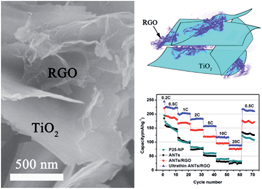A large ultrathin anatase TiO2 nanosheet/reduced graphene oxide composite with enhanced lithium storage capability†
Abstract
A high-quality ultrathin anatase TiO2 nanosheet (ANT)/reduced graphene oxide (RGO) composite is successfully prepared by a simple one-step hydrothermal synthetic route. The unique 2-D integrative features and mesoporous characteristic of the ultrathin ATN/RGO composite with a large surface area and outstanding stability are very favorable for lithium storage. A high initial discharge capacity (256.4 mA h g−1 at 0.2C), a high initial Coulombic efficiency (86%), a high rate capability (225.7, 202, 183, 157, 118 and 88.3 mA h g−1 at 0.5, 1, 2, 5, 10, and 20C, respectively, 1C = 167.5 mA h g−1), and a superior cyclability (174.2 mA h g−1 after 200 cycles at 1C and 112.9 mA h g−1 after 260 cycles at 10C) are achieved by using the ultrathin ATN/RGO composite as an anode material for lithium-ion-batteries. A detailed comparative study of the electrochemical properties of P25 nanoparticles, ATNs, ATN/RGO, and ultrathin ATN/RGO composites reveals that the significantly enhanced lithium storage capability is attributed to the ultrathin TiO2 nanosheets with short ion diffusion paths facilitating Li+ insertion/extraction, RGO conductive supports for fast electron transport, and the extra Li storage at the RGO/TiO2 interface.


 Please wait while we load your content...
Please wait while we load your content...